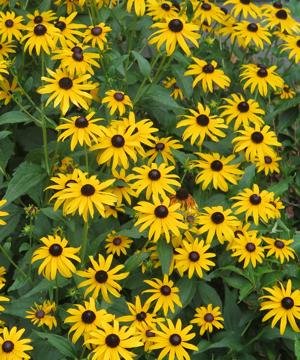It’s time to plan your easy-care landscape
By Mary Fran McClure
WSU Chelan/Douglas County Master Gardener


We’ve had our fill of the cold and aren’t we all hankering for spring? It’s time to seriously plan landscapes with colorful, easy-care flowers, whether annuals or perennials.
It’s too early for planting some hot weather plants, but certainly not too early to be researching and planning your low maintenance flowers.
Climate change is a factor to consider. It’s important to identify plants that can take our warmer summers in stride.
Luckily, we have tough plants that are both hardy and heat resistant. Many have the bonus of being less thirsty, although most will bloom more profusely with regular watering.
A popular name for gloriosa daisies are black-eyed Susans, although their Latin name is Rudbeckia hirta. Their big, yellow/orange blooms are about 3 to 4 inches across, centered by impressive dark seed heads held high above those radiating petals. This short-lived perennial multiplies easily, so just dig out the older plants every few years and keep the newer, surrounding ones. There are very attractive reddish ones such as “Cherry Brandy,” “Cherokee Sunset” and “Cappuccino.” Shorter ones include 9- to 10-inch-high “Goldilocks” and “Toto.”
Related charmers include R. Ratibida (Mexican Hat) and Echinacea (coneflower) and our ever-popular annual sunflowers. My favorite sunflowers range from 4 to 6 feet high, and I save mature seeds the goldfinches can’t reach for next season’s crop.
Penstemons are another low-water but short-lived perennial. Native to our mountainous regions, their cup-shaped flowers are perfect for attracting hummingbirds and bees. Bloom colors include red, pink, white and purple.
A couple of years ago, I wrote about the glories of sedums; they are low maintenance, heat tolerant, and come in a multitude of interesting colors and shapes.
Once established, their thick, succulent leaves hold water so they can thrive on less irrigation. Low sedums are popular in the front of the flower bed or as ground covers. Varieties offer a range of leaf color and pattern that is amazing, from silvery purples to spring greens to golden yellows. Bloom colors include yellow, pink, white, orange and red.
The old standby sedum “Autumn Joy” sports pink flower clusters in summer that attract butterflies, and in fall slowly turns golden brown. Cut off those old flowerheads and stalks to enjoy new, green growth.
Sprinkle around some fine alyssum annual seeds that grow quickly to fill in and mix nicely in front of a perennial border of taller plants.
Annuals worth checking out in addition to sunflowers include marigolds and zinnias. These two popular annuals come in just about any height and color you can imagine — except blue.
These annuals need warm soil and heat, so hold off planting for a month or so.
Perennials listed above are more comfortable in spring temperatures.
Plenty of appealing, low maintenance flowers are a welcome addition to your upcoming landscape this year, and now that we’re just barely into spring, it’s time to get in gear.
